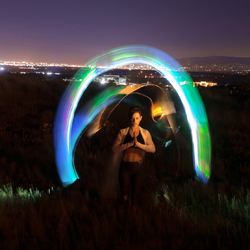
Research by a digital anthropologist is looking at how new religious movements are harnessing online platforms. These ‘invented religions’ take inspiration from ancient philosophy and recent cultural events to develop doctrine and communities of believers in digital spaces.
Research by a digital anthropologist is looking at how new religious movements are harnessing online platforms. These ‘invented religions’ take inspiration from ancient philosophy and recent cultural events to develop doctrine and communities of believers in digital spaces.
Emergent spiritual forms are just the repetition of previous ways of making sense of the world
Beth Singler
In the 2001 Census, 0.7% of the UK population - some 390,127 - declared themselves Jedi: the mystical religion from legendary film franchise Star Wars. This was a result of a viral online campaign to ridicule, or ‘troll’, the Census, which had dared to ask the religion question for the first time in living memory.
Ten years later, the digital gag apparently on the wane, less than half that number self-selected as a Jedi - although the 2011 number was not insignificant. There are allegedly 176, 632 Jedis in the UK.
The Office of National Statistics coded Jedi under ‘no religion’, seeing it simply as an atheistic prank. For most, this is likely accurate. But a minority do, in fact, practise Jediism - a spiritual and religious philosophy that, while looking to Star Wars as the primary source text, is developing in its own right through online communities of believers.
Beth Singler, a researcher at the University’s Faculty of Divinity, is a digital anthropologist studying new religious movements. She says that social media and digital networks allow practicing Jedis to formulate their observances, doctrine and ritual beyond the parameters originally laid out by Star Wars creator George Lucas, filling in gaps and negotiating the directions of this emerging faith - a faith in which they find meaning.
“Jedis see it as an aspirational religion, a positively-aimed system,” she said. “It’s not entirely worked out within the Star Wars universe, so Jedis are creating their own texts referring to Daoism, Buddhism, and Catholicism even. They are working out the master/apprentice system the films provided, and how that’s navigated online when the master is in Texas and the apprentice in Bavaria.
“The Jedi community talk about the role of George Lucas as a storyteller who appropriated ideas from different places and by merging them in Jediism formed a kind of truth - a truth they can pick up and run with. At points, the line between fandom and religion becomes quite diffuse.”
For Singler, Jediism is one of a number of new religious movements and spiritualities such as Scientology, Wicca and the Indigo Children that are using digital platforms to create new traditions and build communities. Part of the attraction of these ‘invented religions’ and spiritualities is being involved in the establishment of a belief system and, as arguably with all religions, acceptance from a community of like-minded believers.
Singler says that these new religions increasingly use the digital world to map religious development, providing new sources of tradition that movements can reference to ‘prove’ themselves and the legitimacy of their faith. This raises a question as old as religion itself: what actually constitutes a religion? Do you need centuries of power and devotion, or a number of people with a common belief?
Singler describes herself as, in a sense, the “anti-Dawkins”. While the furiously atheist Professor Dawkins believes all religion to be irrational, for Singler, religious movements are all “equally rational”.
“As a social anthropologist, I’m not debating the truth of belief or whether there’s a god. Once you bracket that question off, one is left with social manifestations; I would say the social manifestations of religions throughout time are equally rational: responses to hopes and expectations, social pressures and changes. Emergent spiritual forms are just the repetition of previous ways of making sense of the world.”
Singler estimates a vocal Jedi community to be roughly 2,000 strong in the UK, not much smaller than the Census figure for Scientology, the new religious movement that has fought hardest for what it sees as official ‘legitimacy’: waging a decades-long struggle with a number of governments to be given the tax-exempt charitable status afforded major religions.
The Jedi themselves were mentioned in a proposed amendment during the drafting of the UK’s Racial and Religious Hatred Act 2005 (“we have to face up to the fact that Jedi Knights seemed to feature in the census return as being the belief of rather a large number of people”). Again this raised the thorny issue of what is and is not a religion, described by one MP as going to the “heart of the Bill”. In the end, the Bill side-stepped the issue with a vagueness that caused consternation among satirists, who feared they would face prosecution under the Act for being deemed offensive.
For her research, Singler follows online debates, pulls at threads and scours Facebook groups - conducting interviews both on and offline. As someone raised with the internet, she says objectivity is critical: “It’s not like the traditional mode of anthropology where you join remote tribal communities; it can be easy to assume that people are using language in the same way as you, and are similar to you. It’s an increasing problem as ethnography shifts into digital.”
One of the new formations Singler focuses on are the Indigo Children. Part of the broader New Age movement, Indigos were first identified by psychic Nancy Ann Tappe in the late 70s. Tappe saw a new generation of children born with different colour auras who would be the harbingers of a new age of spiritual enlightenment. For Singler, the idea that a special generation of people are here to save us is a trope that everyone from medieval historians (the Children’s Crusade) to comic book fans (X-Men) will find familiar.
Part of the belief system for Indigo Children is that they are here to break paradigms, and don’t fit well into mainstream society. Indigos will often demedicalise conditions such as ADHD and Autism - seeing them more as manifestations of the disruptive characteristics of these individuals. The Indigo Child concept allows people to reinterpret personal histories (“this is why I didn’t fit in”) and ascribe the religion to historical figures (“Joan of Arc is considered by some to be an ‘Indigo’”). 
Using Twitter to research Indigos, Singler found hallmarks of this belief system in a perhaps unlikely cultural space: hip-hop. “There is a whole thread of Indigoism going on in hip-hop, specifically the experimental Brooklyn-based movement Beast Coast. For these artists, Indigo thinking is a part of the human potential movement that ties into things like the 1%er culture and the Nation of Islam. Lyrics reflect new age ideas such as ‘the third eye’, ‘awakening to the truth’ and not being ‘sheeple’, or unawaken.” Beast Coast figureheads The Underachievers titled their debut release ‘Indigoism’.
While this idea of self-awareness in religious observance might seem to be a fairly new practice, one amplified by digital technology, Singler isn’t sure. She points to Victorian spiritualism as an example of another boom period of new religious movements - and one influenced by different technologies. “The Fox sisters were one of the key triggers for the spiritualism movements in the mid-19th century. They were the first to interpret rapping noises as channelled spirit messages from beyond - at the same time the telegraph system was sweeping the western world.”
However, Singler admits that the internet allows new religious movements to get more publicity, and provides an enabling space. Even the Wicca, with its nostalgia for the rural, pagan and ancient, are far from luddites when it comes to new technology:
“Wiccans were early adopters of many social media channels - and remain very active. Many are vocal online campaigners for environmental issues. There are even online witch schools, for example, with regular time slots to log in for sessions and rituals.”
But Singler insists she is not a ‘technological determinist’. “Yes, the digital world allows collectivity, but the internet doesn’t create us, we create the internet and then it becomes a new space for us to continue being what we’ve always been. The formation of new religious movements is far from a new phenomenon, it’s just humans being humans.”
Inset image: Yoga Auras by A4gpa
The text in this work is licensed under a Creative Commons Licence. If you use this content on your site please link back to this page. For image rights, please see the credits associated with each individual image.





